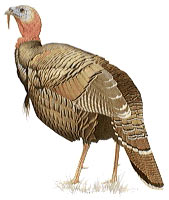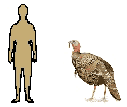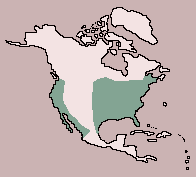Turkey

| Class: Aves: Birds |
Diet: Seeds, nuts,
berries, insects |
| Order:
Galliformes: Gamebirds |
| Size: body:91
- 122 cm (36 - 48 in) |
| Family: Meleagridinae:
Turkeys |
Conservation Status:
Non-threatened |
| Scientific Name:
Meleagris gallopavo |
Habitat: wooded country |
| Range:
U.S.A., Mexico |
 The
wild turkey has a lighter, slimmer body and longer legs than the domesticated
version. Turkeys are strong fliers over short distances. They roost in
trees but find most of their food on the ground and eat plant matter, such
as seeds, nuts and berries, as well as some insects and small reptiles.
A breeding male has a harem of several females. Each female lays her eggs
in a shallow, leaf-lined nest on the ground; sometimes two or more females
use the same nest. The female incubates the clutch of 8 to 15 eggs for
about 28 days and cares for the young. The sexes segregate after breeding. The
wild turkey has a lighter, slimmer body and longer legs than the domesticated
version. Turkeys are strong fliers over short distances. They roost in
trees but find most of their food on the ground and eat plant matter, such
as seeds, nuts and berries, as well as some insects and small reptiles.
A breeding male has a harem of several females. Each female lays her eggs
in a shallow, leaf-lined nest on the ground; sometimes two or more females
use the same nest. The female incubates the clutch of 8 to 15 eggs for
about 28 days and cares for the young. The sexes segregate after breeding.

  
|
